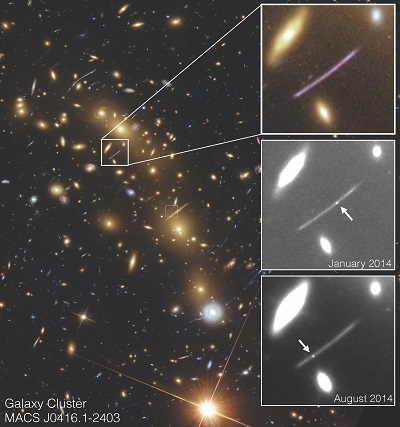The most distant single star ever detected
Two ‘twinkling’ stars in galaxies billions of light years away have been spotted thanks to the gravity-based magnifying power of the galactic clusters between the stars and us, report two papers published online this week in Nature Astronomy.

Spock, whose official name is HFF14Spo, was actually two events that occurred in January and August 2014, see the two bottom insets. A colour image of the lensed host galaxy, which is located 8 billion light years away, is shown in the top inset. The galaxy is lensed by the galaxy cluster MACS J0416.1-2430 located about 4 billion light years away.
One of the stars (dubbed Icarus) — which is 9 billion light years away — was magnified over 2,000 times, an unprecedented observation that simultaneously reveals information on the dark matter hidden in the magnifying cluster in question. It is by far the most distant single star ever detected. Icarus is twinkling because of the relative motion between the lensed star and the lensing cluster.
The other ‘star’ (dubbed Spock) is of completely unknown nature but its twinkles appear to be due to repeating eruptions. The hunt is now on to find other such events to uncover Spock’s inner secrets.
Studying these twinkles, the authors can reveal not only the physical properties of the stars themselves, but also the distribution of the dark matter — the material that cannot be directly observed but whose additional mass is thought to explain the observed internal motions of galaxies — in the lensing galaxy clusters.
DARK astronomers helped monitor the brightness of Icarus (led by PhD student Jonatan Selsing) and determined the distance to Spock to be 8 billion light years (led by VILLUM Investigator Jens Hjorth) using ESO’s Very Large Telescope (VLT). Associate Professor Lise Christensen assisted with the observations of Icarus and Affiliate Associate Professor Claudio Grillo helped model the dark matter in the clusters of galaxies and confirmed the distance to Spock, also with the VLT. The team plans to search for many more twinkling stars as part of the Young Supernova Experiment using the Pan-STARRS facility in Hawaii and the future James Webb Telescope.
Links to additional documentation
Scientific reports in Nature Astronomy:
Nature Astronomy News and Views article:
Contact:
- Jonatan Selsing (DARK, Niels Bohr Institute, University of Copenhagen, Denmark
E-mail: jselsing@dark-cosmology.dk - Jens Hjorth (DARK, Niels Bohr Institute, University of Copenhagen, Denmark)
E-mail: jens@dark-cosmology.dk - Patrick Kelly (University of California, Berkeley, Berkeley, CA, USA)
E-mail: pkelly@umn.edu - Steven Rodney (University of South Carolina, Columbia, SC, USA)
E-mail: srodney@sc.edu
NASA press release on Icarus:
Icarus videos:
Additional Spock images and videos:
Contact
Jonatan Selsing (DARK, Niels Bohr Institute, University of Copenhagen, Denmark E-mail: jselsing@dark-cosmology.dk
Jens Hjorth (DARK, Niels Bohr Institute, University of Copenhagen, Denmark) E-mail: jens@dark-cosmology.dk
Patrick Kelly (University of California, Berkeley, Berkeley, CA, USA) E-mail: pkelly@umn.edu
Steven Rodney (University of South Carolina, Columbia, SC, USA) E-mail: srodney@sc.edu
